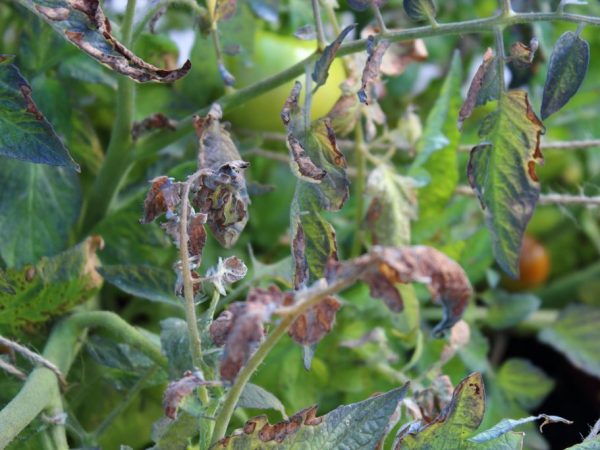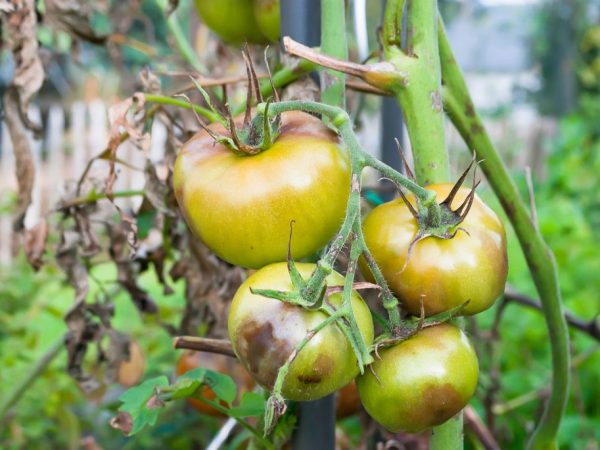Treatment of tomato cladosporiosis
Cladosporium disease in tomatoes is the most common. The second name of the disease is brown leaf spot. It is not so easy to cure a disease. Most often, it is found in crops grown in greenhouses or greenhouses, plants growing in open ground are rarely affected. The biggest danger is that the leaf staining fungus can withstand frost and drought.

Treatment of tomato cladosporiosis
How to recognize an ailment and what it is
Before starting the treatment of tomato cladosporiosis, it is necessary to study the characteristics of the disease and learn how to determine it according to the main signs. It is necessary to conduct a thorough examination of each bush. The main symptoms of a fungal infection are:
- during the active growth of seedlings and flowering, gray spots appear, which in their appearance are very similar to rot, on the inside of the foliage: small dots of a yellow-green hue are visible from the outside;
- stopping the development of fetuses;
- drying of the deciduous part of tomatoes.
At the second stage, the supply of nutrients to the stem and rhizome is blocked, which provokes a slowdown in the growth of the tomatoes themselves. Ripening and growth of tomatoes is greatly slowed down. Cladosporiosis of tomatoes at the last stage leads to the death of the plant. The deciduous part dries and curls. Before this, the fruits acquire a brown tint, and the bottom of the leaves is completely covered with rot.
Favorable conditions for the development of the fungus are high humidity and temperature conditions in the range of 22-25 ° C. The fungus is most often transmitted by airborne droplets, during the airing of the greenhouse or watering, by spraying. Pathogenic microorganisms are represented by a huge number of genera.
Varieties of therapy
It is better to start treatment of the disease at an early stage, then there is a very high probability of maintaining the yield and getting rid of the fungus completely. When the humidity drops to 60%, new symptoms of the disease appear rather rarely. It is better, of course, to choose hybrid tomato varieties that are resistant to fungal infection for planting in greenhouses. The methods of struggle involve several types of treatment:
- agrotechnical;
- folk remedies;
- using chemistry.
Treatment methods should be selected depending on the variety. Even the most resistant tomato varieties are not susceptible to a certain strain of cladosporium disease. You need to start fighting the disease when you find the first symptoms. In many ways, the spread of tomato disease is influenced by the correct care of crops; without favorable conditions, disputes will not germinate. First of all, you should remove the affected leaves or plants completely, and also change the strategy of caring for them so that you do not have to use fungicides in the future.
Agrotechnical method
Agrotechnical methods of control involve the removal of all affected leaves, frequent ventilation of the greenhouse and a reduction in the frequency of watering.Plants need to be watered about 1 time per week. To reduce the risk of the spread of the fungus, you need to cover the soil between the plants with dark plastic wrap, and also remove all leaves on which the borax is visible.
Infected leaves must be removed with extreme care to prevent contamination of surrounding plants. To do this, take a plastic bag and carefully put it on the affected area, and then pinch off. Ideally, the affected plant should be removed completely and burned to prevent the spread of spores. The thing is that the spores of the fungus are very similar in appearance to dust, and when they get on the leaves, under favorable conditions, they begin to actively germinate, blocking the processes of tomato photosynthesis.
Traditional methods

You can fight the disease with folk methods
To fight the disease, if the previous method did not fit, you can use folk remedies. Such methods are much safer than using fungicides, but their effectiveness will depend on many aspects. Tomato cladosporium has been terrorizing gardeners for many years, so people have long learned to fight it. One of the most common methods of fighting folk remedies is watering and spraying with an aqueous solution of potassium permanganate. The watering solution should be pale pink in color.
The most versatile remedy is garlic. He is good in the treatment of human diseases and will help plants effectively get rid of fungal infections. To prepare the solution, you will need: 0.5 kg of garlic, 30 drops of iodine per 10 liters. water. With such a composition, it is necessary to process all bushes, both affected and healthy. Treatment should start with healthy plants.
In combination with watering and spraying with potassium permanganate, it is recommended to use parallel watering with ash decoction. 10 liters. water you need to take 300 g of ash and boil it for 15 minutes. An effective remedy is considered baby or laundry soap, which should be added in a small amount to water for irrigation and spraying.
Chemical Compositions
If the fight against cladosporiosis turned out to be in vain, you will have to resort to radical methods and use fungicides - chemical preparations of a wide spectrum of action. One of these drugs is Bravo. The treatment started on time gives great efficiency, that is, when there is a possibility of infection, the drug should be introduced, even at the planting stage, when the infection has not yet occurred. If the drug is used at a time when the symptoms of the disease have already begun to appear, then precautions must be taken because the drug has a rather high toxicity for animals, bees and birds, it is also prohibited to use fungicides of this type in the immediate vicinity of water bodies.
The dosage of the drug is calculated depending on the area of the planted crops. Another effective drug for getting rid of a fungal disease is Ditan Neo Tek. It belongs to a wide spectrum of fungicides. Shows the greatest efficiency when treated before infection with a fungus. It is important to observe the interval between treatments in 7-10 days, so that there is no infection of the new growth.
The presented fungicides of the new generation continue their action, even after precipitation, the main thing is that after processing, moisture does not get into the ground for 3-6 hours. Processing should be carried out after the plants have dried out from dew or precipitation. Prevents the emergence of resistance in pathogen strains. For the treatment and prevention of the disease, several more drugs can be used:
- Pseudobacteria 2;
- Phtosporin;
- Abiga Peak.
For all the effectiveness of drugs, fungicides are quite toxic. This method is not suitable for everyone, so many gardeners are trying to cope with the disease with folk remedies.The main measure to combat the disease is timely prevention and proper care.
Prophylaxis
The source of the infectious disease of conidia is on plant remains. They can remain viable for several months, even at low air temperatures and aridity, so the main method of prevention is to completely clean the areas from the remnants of infected plants. Preventive measures to prevent cladosporium disease allow you to avoid problems with infection in the future and grow a good harvest. Main preventive measures:
- humidity in the walls of the greenhouse 60-70%;
- temperature regime 18-20 ° C;
- complete destruction of the remains of last year's plants by burning;
- process the seeds before sowing with a solution of potassium permanganate;
- prevent waterlogging of the ground-mixture;
- you can process the bushes with copper sulfate.
Prevention measures include planting varieties that are resistant to the disease. All of the above measures to prevent the disease are effective when growing crops in a greenhouse. In the open field, cladosporiosis affects plants much less often. In order not to look for ways to combat cladosporia, you need to think about the selection of crops for growing. Disease resistant tomato varieties are listed below.
- "Our Masha".
- Space is old.
- "Delicacy".
- "Funtik".
- "Evpator".
- "Vezha".
Final part
Using various methods of combating cladosporia, you need to remember about safety precautions, especially when fungicides and other toxic drugs are used. It is preferable to choose a method of treatment with folk remedies, but if you still had to use chemistry, you need to carefully study the instructions for use. When treated with chemistry, adult plants will absorb some of the chemical components in any case.
In order not to poison your loved ones, you need to wait at least 3 weeks before eating processed fruits. Only broad spectrum fungicides should be used for treatment. It is important to observe safety precautions during the processing itself. If infected plants are found, it is best to immediately destroy them, and treat healthy bushes with a manganese solution.


